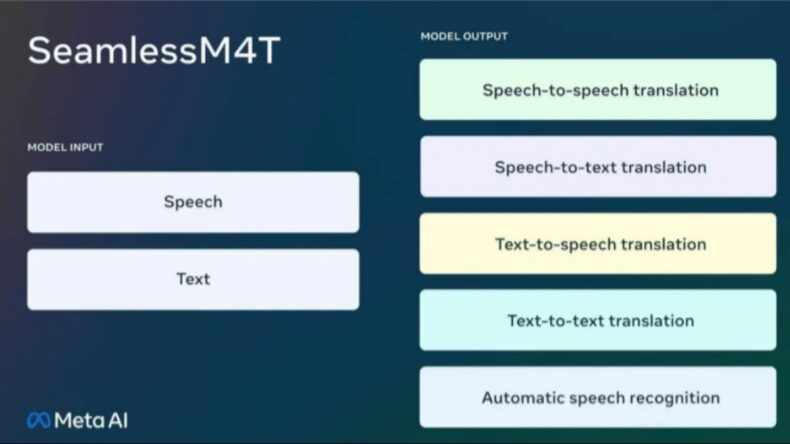Meta’s SeamlessM4T, an AI model developed by the company has the ability to translate and transcribe up to 100 languages in both text and speech.
Meta has introduced a new model through which it wants to increase interconnection and provide consumers access to more information in other languages. According to the blog post on Meta’s official website, Meta said that it is currently releasing SeamlessM4T, the first all-in-one multimodal and multilingual translation framework that enables individuals to easily communicate through speech and text across several languages.
Table of Contents
What is SeamlessM4T
- It is the first integrated multilingual multimodal AI translation and transcription model.
- Moreover, depending upon the requirements, this single model can translate up to 100 languages from text to speech, text to text, speech to text, and text to speech.
Moreover, Meta has openly released SeamlessM4T under a research license to enable academics and developers to expand on this work, in keeping with their mission to open Science. Additionally, the company is making available the information for SeamlessAlign, which contains 270000 hours worth of mined speech and text alignments and is the largest open multimodal translation dataset to date.
What does Meta’s SeamlessM4T Support
Meta’s SeamlessM4T support the following features:
- Speech synthesis for about 100 languages
- Translation from speech to text in about 100 input and output languages
- Speech-to-speech conversion with approximately 100 supported input languages and 36 supported output languages, including English
- Translation from text to text in approximately 100 languages.
- Supporting 35 output languages, including English, and over 100 input languages in text-to-speech translation.
What is Seamless M4T Built On
This endeavor builds on the developments Meta and others have made in the search for a universal translation over the years. No Language Left Behind (NLLB), a text-to-text machine translation model that was introduced last year now supports 200 languages and is now one of Wikipedia’s translation providers.
Additionally, the first direct speech-to-speech translation solution for Hokkien, a language without a widely used writing system, was shared by us a few months later when the company presented a demo of their Universal Speech Translator. Massively Multilingual Speech, which offers automatic speech recognition, language identification, and speech synthesis technology spanning more than 1,100 languages, was also provided earlier this year.
Meta’s SeamlessM4T builds on discoveries from all of these research projects in order to provide a multilingual and multimodal translation experience originating from a single model, constructed across a wide range of spoken data sources, and with cutting-edge outcomes.
Building Approach for Seamless M4T System
A lightweight sequence modeling toolkit that is simple to combine with other contemporary PyTorch ecosystem tools is necessary to create a unified model. The company redesigned fairseq, the initial sequence modeling toolbox it created. Also, fairseq2 contributed to the modeling powering SeamlessM4T by providing more effective modeling and data-loader APIs.
The building approach for Seamless M4T system included using Multitask UnitY model architecture, which can instantly produce translated text and speech. The same translations that are already a part of the standard UnitY model are supported by this new architecture as well, including automatic speech recognition, text-to-text, text-to-speech, speech-to-text, and speech-to-speech translations. Moreover, it comprises three sequential elements.

Nearly 100 languages’ worth of speech input must be recognized by text and speech encoders. The text decoder subsequently converts that meaning into almost 100 different languages for text, and then a text-to-unit framework decodes that meaning into distinct acoustic units for 36 different spoken languages. The single-system approach used by SeamlessM4T reduces errors and delays. It improves the translation process’ effectiveness and quality.
Conclusion
The all-in-one multilingual AI translation framework Seamless M4T serves as a testament to Meta’s commitment to innovation, and accessibility, and it holds the potential to reduce linguistic barriers worldwide. Thus, we can easily see the future of seamless, multimodal translation here that is promising greater accuracy and efficiency in cross-lingual communication.













